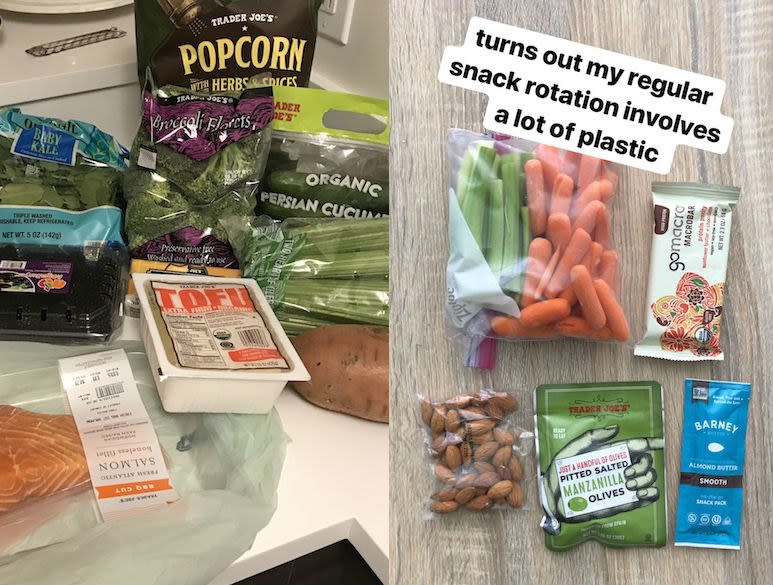I Tried Avoiding Single-Use Plastic for a Week and OMG Was It Hard
Single-use plastic is everywhere, which I never quite realized until I tried to stop using it.
Back in college, I started thinking about the amount of rubbish I produce. I’ve made a bunch of easy swaps like using a reusable water bottle and taking my own bags to the grocery store, but I had been pretty complacent about my waste disposal systems. After I came across a nasty video of a sea turtle with a plastic straw stuck way up its nostril earlier this month, I thought a bit harder about my plastic use in particular.
According to a 2016 Institute for European Environmental Policy (IEEP) report, plastic waste is a major source of ocean litter, and certain products can be very dangerous to marine animals. Obviously, plastic is an incredibly useful material, especially for food packaging. It’s lightweight, cheap, and easy to produce. The problem is that it doesn’t degrade the way paper or other materials do. As such, it can sit in landfills for decades—or find its way into places it shouldn’t (like the ocean, and turtles’ nostrils).
It dawned on me (if not suddenly, at least more strongly) that perhaps I could be doing more to contribute less to the problem, so I looked into the recycling options where I live—New York City—to see where I could improve. I set out to eliminate non-recyclable plastics from my life. At least for some period of time.
For a week, I tried not to use any plastic item I couldn’t recycle in my building’s basement—and it was actually quite difficult.
Per the New York recycling guidelines, I can recycle rigid plastic items in my apartment building’s recycling bins, which live in the basement—that’s anything that’s inflexible like clamshell food packaging, bottle lids, yogurt cups, plastic bottles, and plastic soup and takeout containers. But there’s plenty of other, non-rigid plastic that I regularly use like Ziploc bags, plastic straws, grocery bags, produce bags at the grocery store, drink stirrers, and all sorts of flexible food packaging (like the thin plastic bags washed salad greens and veggies come in, or the plastic wrapping used on meat and fish). These types of plastic are generally referred to as flexible plastic and plastic film, and you can recycle some of it—but usually not in your apartment building basement or curbside bin. According to PlasticFilmRecycling.org, you have to take these items to a grocery store or drop-off location that accepts plastic film, and even then they generally don’t accept salad mix bags, frozen food bags, or the plastic rings from six-packs.

SingleUsePlastic1
The most major change was adapting the way I grocery shop.
I do most of my grocery shopping at Trader Joe’s and Whole Foods, because I like their products and they are relatively convenient to get to. Both of these companies are publicly dedicated to eco-friendly practices and say they try to use recycled and recyclable materials as much as possible. In a January 2018 blog post, Trader Joe’s said they’re working on biodegradable produce bags. And the Whole Foods “green mission” webpage states that the store is in the process of “replacing traditional plastic and paper prepared-food containers with compostable fiber packaging made from renewable resources.” In the meantime… there’s still a lot of plastic there.
My usual weekly food haul includes salmon, tofu, pre-washed greens, baby carrots, snack packs of nuts and olives, string cheese, and bagged popcorn. You guessed it! These items tend to come in the exact type of plastic packaging I was trying to avoid—so I had to find suitable alternatives. Because I didn’t want to spring for a reusable produce bag, I purchased whole fruits and veggies that would be okay without bagging like squash, sweet potatoes, and grapefruits. But I could not for the life of me find fish that didn’t come wrapped in either plastic film or in wax paper, which is a material you cannot recycle.
I was also quite mindful of how I transported food around.
I usually have about six snacks in my backpack at any given time, most of them in a plastic container of some sorts. Instead of using Ziploc bags, I put celery sticks into a mason jar. I used a little cheesecloth bag to ferry around almonds, and ditched my beloved, plastic-wrapped energy bars and almond butter snack packs for the week.
And at work events, I paid attention to how food and drink was served.
I went to a couple of events during the week of my plastic experiment. One of those was a wine tasting, and we were served drinks in glass cups with paper straws—yay! The second event was much larger, and the drinks were served with plastic cups and straws. I skipped the straw, and did use the plastic cups after the bartender told me they planned to recycle them. I avoided the food, which was served on paper plates with plastic serveware. In theory, plastic knives, forks, and spoons can be recycled. But in practice, they have to be completely clean and free of any food residue, and the chances of one of the hardworking event staff having the time to clean and recycle each individual fork seemed pretty low. So, no plastic cutlery for me.
I also encountered small, everyday pieces of plastic I never previously thought about.
The lid on a to-go coffee cup? Plastic. The packaging on my favorite K-beauty sheet mask? Plastic. Clip-on name tags at a professional event? Plastic. Medication packaging? Plastic.
By the end of the week, I found that a lot of my brain space was dedicated to plastic.
I found myself staring at a pomegranate for five minutes while pondering whether the large sticker on it was a.) plastic and b.) recyclable. Becoming more aware of what food packaging is out there and what other options I have access to was helpful, but agonizing over individual fruits was not.
It was a genuine relief when this self-imposed experiment was over. Going forward, I hope to use significantly less of the hard-to-recycle plastic. For example, I’ll continue to buy pre-washed greens, but I’ll look for greens in rigid packaging that I can easily recycle rather than the thin salad bags. I also plan to shop more often at the farmer’s market, where lots of produce comes in cardboard containers. I may even get some reusable produce bags! But… what if they come in plastic packaging?


